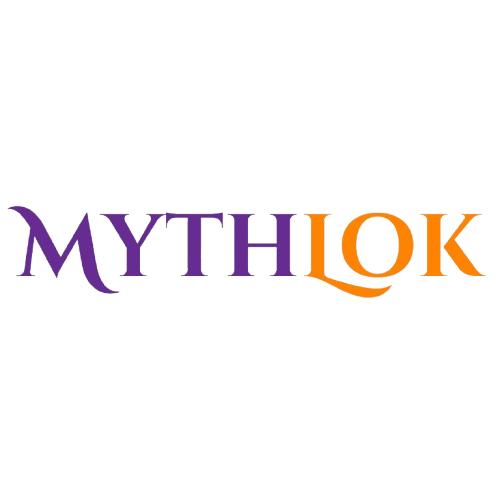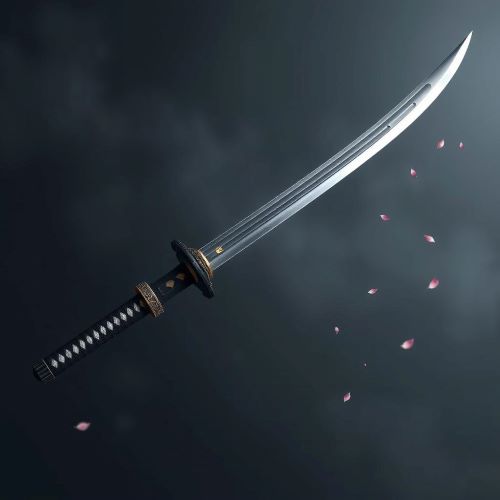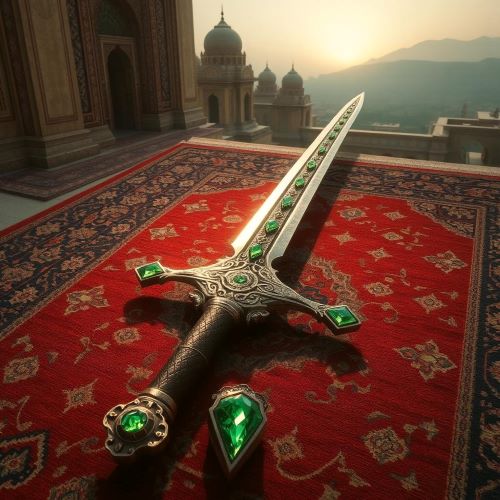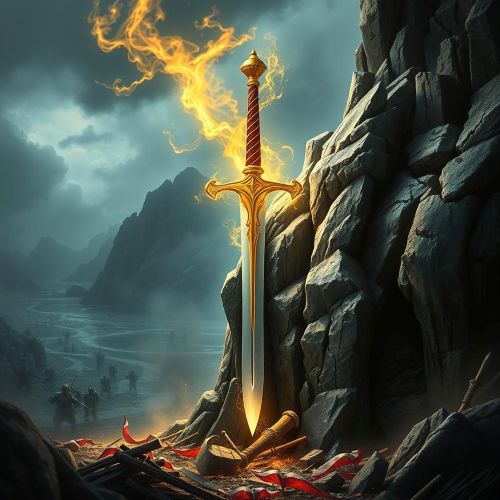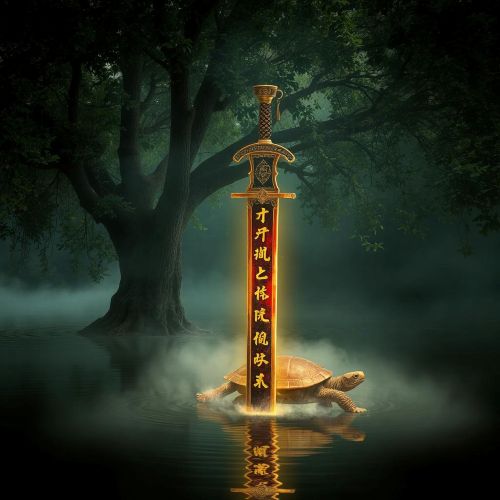Caladbolg : The Lightning Sword
Caladbolg
Introduction
Irish mythology brims with tales of gods, heroes, and enchanted artifacts, with legendary weapons playing a crucial role in these stories. More than mere instruments of war, these arms are imbued with extraordinary power and deep ties to the land and its people. Among them, Caladbolg stands out as a sword of immense strength and symbolic importance. Known as the “Hard Cleft” or the “Lightning Sword,” it is often likened to Excalibur from Arthurian legend. Beyond its formidable nature, Caladbolg represents heroism, authority, and supernatural might in Celtic lore.
Origins
Caladbolg features prominently in the Ulster Cycle of Irish mythology, where it is wielded by Fergus mac Róich, a formidable warrior and former king of Ulster. Its name, meaning “Hard Lightning” or “Hard Cleft,” reflects its immense power and sharpness. Unlike many legendary swords with a singular origin story, Caladbolg’s creation remains shrouded in mystery, adding to its mythical allure.
Often described as a massive two-handed greatsword, it required exceptional strength to wield. Some scholars draw parallels between Caladbolg and the Welsh Caledfwlch, the precursor to Excalibur, suggesting a shared Celtic influence. This connection underscores the deep interweaving of mythologies across the Celtic world.
Think you know your myths and legends? Dive into the world of ancient stories and test your knowledge with our engaging quizzes on Mythlok!
Powers
Caladbolg is far more than a mere blade—it is a weapon of legendary might, imbued with supernatural properties. Its most famous ability is its devastating cutting power, capable of slicing through anything in its path. In Táin Bó Cuailnge (The Cattle Raid of Cooley), Fergus mac Róich demonstrates this by leveling three hills in Meath with a single strike.
Another striking feature of Caladbolg is its radiant arc, said to create a rainbow when swung. This luminous effect may symbolize a connection to the divine or the Otherworld, reinforcing the sword’s mystical nature. Some interpretations suggest this phenomenon stems from the sword’s ability to manipulate light, adding another layer of enchantment.
Beyond its physical prowess, Caladbolg is also a symbol of authority and warrior supremacy. Legends describe it as capable of annihilating entire armies in a single sweep, underscoring both its power and the responsibility that comes with wielding it. Its association with lightning further cements its status as a force of destruction, embodying both the glory and peril of unchecked strength in battle.
Owners/Users
Fergus mac Róich, a key figure in the Ulster Cycle, is the most renowned wielder of Caladbolg. A warrior of immense strength and a former king of Ulster, he is depicted as both a fierce combatant and a larger-than-life character known for his passions and tragic fate. His possession of Caladbolg reinforces his legendary status, with the sword serving as a symbol of his lost power and rightful place in history.
Interestingly, Caladbolg is also linked to Fergus mac Léti, a lesser-known Ulster hero. This dual association suggests either a blending of myths or the sword’s role as a recurring emblem of warrior prowess in Irish storytelling. While Fergus mac Róich remains its most famous wielder, the sword’s legend extends beyond him, influencing later myths and drawing comparisons to other powerful weapons in Celtic lore.
Instances used
The most famous tale featuring Caladbolg unfolds in the Ulster Cycle, particularly during the events of Táin Bó Cúailnge (The Cattle Raid of Cooley), one of Ireland’s greatest epics.
During this legendary conflict, Fergus mac Róich, once a king of Ulster, finds himself fighting against his former allies while serving Queen Medb of Connacht. When called upon to wield Caladbolg in battle, Fergus chooses restraint over bloodshed. Rather than turning the blade against his former comrades, he demonstrates its devastating power by cutting down an entire forest with a single strike. This act is both an assertion of dominance and a reflection of Fergus’s inner conflict—torn between his sense of honor and his current allegiance.
Beyond its physical destruction, Caladbolg serves as a powerful symbol in the story. It represents Fergus’s lost authority, his struggle between loyalty and duty, and the weight of past betrayals. Another significant moment occurs when Ailill mac Máta, Medb’s husband, seizes the sword from Fergus after discovering his affair with Medb. This theft underscores Caladbolg’s status as a coveted object of power, its possession conferring both strength and legitimacy.
Although Caladbolg’s appearances in myth are limited, each instance is charged with meaning, cementing its legacy as one of the most formidable weapons in Irish mythology.
Frequently Asked Questions
Lorem ipsum dolor sit amet, consectetur adipiscing?
Lorem ipsum dolor sit amet, consectetur adipiscing elit. Praesent convallis vestibulum justo, ac tincidunt nunc vehicula quis. Nullam id dolor quis orci malesuada feugiat. Curabitur aliquet libero at urna ullamcorper, ac ultricies nulla dapibus.
Lorem ipsum dolor sit amet, consectetur adipiscing?
Lorem ipsum dolor sit amet, consectetur adipiscing elit. Praesent convallis vestibulum justo, ac tincidunt nunc vehicula quis. Nullam id dolor quis orci malesuada feugiat. Curabitur aliquet libero at urna ullamcorper, ac ultricies nulla dapibus.
Lorem ipsum dolor sit amet, consectetur adipiscing?
Lorem ipsum dolor sit amet, consectetur adipiscing elit. Praesent convallis vestibulum justo, ac tincidunt nunc vehicula quis. Nullam id dolor quis orci malesuada feugiat. Curabitur aliquet libero at urna ullamcorper, ac ultricies nulla dapibus.
Lorem ipsum dolor sit amet, consectetur adipiscing?
Lorem ipsum dolor sit amet, consectetur adipiscing elit. Praesent convallis vestibulum justo, ac tincidunt nunc vehicula quis. Nullam id dolor quis orci malesuada feugiat. Curabitur aliquet libero at urna ullamcorper, ac ultricies nulla dapibus.
Lorem ipsum dolor sit amet, consectetur adipiscing?
Lorem ipsum dolor sit amet, consectetur adipiscing elit. Praesent convallis vestibulum justo, ac tincidunt nunc vehicula quis. Nullam id dolor quis orci malesuada feugiat. Curabitur aliquet libero at urna ullamcorper, ac ultricies nulla dapibus.
Watch
Source
“Caladbolg,” Mythopedia. Accessed at .
“Ulster Cycle Overview,” Encyclopedia Britannica. Available at .
“Legendary Swords of Celtic Mythology,” Ancient History Encyclopedia. Accessed at .
Koch, John T. Celtic Culture: A Historical Encyclopedia. ABC-CLIO, 2006.
MacCana, Proinsias. Celtic Mythology. Hamlyn, 1970.
Ellis, Peter Berresford. A Dictionary of Irish Mythology. Oxford University Press, 1992.
Cross, Tom Peete, and Clark Harris Slover. Ancient Irish Tales. Barnes & Noble, 1996.
“Caladbolg – The Sword Library.” The Sword Library, 11 Feb. 2014, theswordlibrary.blogspot.com/2014/02/caladbolg.html.
“Caladbolg – Oxford Reference.” Oxford Reference, www.oxfordreference.com/display/10.1093/oi/authority.20110803095541974.
“The 20 Most Legendary Weapons From Irish Mythology.” Irish Myths, 7 Feb. 2021, irishmyths.com/2021/02/07/celtic-mythology-weapons/.

